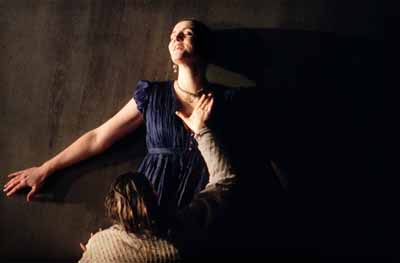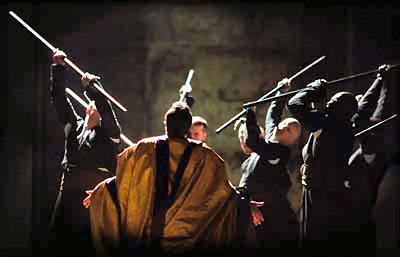Seen and Heard Opera
Review
Mozart, ‘La Clemenza di Tito’
English National Opera, soloists, ENO orchestra, dir. Roland Böer,
London Coliseum, Saturday February 5th 2005 (ME)
‘In the evening to the theatre. The grand opera is not so
grand, and the music very bad, so that almost all of us went to
sleep.’ Thus the Empress Maria Luisa writing to her daughter-in-law
after the first performance of ‘la clemenza’ as ENO
describes it, here given in a beautifully austere production graced
with some very fine singing. Commissioned to celebrate Emperor
Leopold II’s coronation as King of Bohemia in 1791, the
opera was put together in eighteen days whilst Mozart was still
writing the ‘Requiem’ and ‘Die Zauberflöte,’
and it has of course triumphed over its initial poor reception.

In this formal, ‘occasional’ work of just eleven arias,
the singers delineate their characters in Handelian moments of
crisis: a protagonist gives vent to his or her emotions, and we
then move on to the next predicament, and as with a Handel opera,
the singers must have command of a florid technique as well as
elegant phrasing. A thorough grounding in Handelian style was
surely the main reason for the success of Emma Bell’s Vitellia
and Sarah Connolly’s Sesto, both of whose singing matched
the intensity of their characterization. It is not too huge a
step from the role of Rodelinda to that of Vitellia, and Ms Bell’s
singing in the role of the jealous princess was ideally balanced
between intimacy and rage: ‘Deh, se piacer mi vuoi’
was finely phrased, she took the top D in the trio with apparent
ease, and ‘Non più di fiori’ showed an impressive
range, the voice only occasionally hardening under pressure.
‘Non più di fiori’ was also remarkable for
the beautifully judged basset-horn obbligato (Robert Ault) and
the same applied to the clarinet for Sesto’s ‘Parto,
parto,’ played with liquid tone by Anthony Lamb, in a manner
of which Mozart would surely have approved: he wrote to his friend
Anton Stadler (for whom these pieces were written) that he never
should have thought ‘that a clarinet could be capable of
imitating a human voice so deceptively as it was imitated by you…
your instrument has so soft and so lovely a tone that nobody can
resist it who has a heart.’
It would be equally hard to resist the Sesto of Sarah Connolly,
whose beautifully burnished mezzo was heard at its finest in this
role: ‘Parto, parto’ was sung with the kind of engagement
which Brigitte Fassbaender used to bring to the part, but without
the latter’s occasionally breathy phrasing, and her ‘Deh,
per questo istante solo’ was confidently phrased: at the
moment her interpretation just needs a little more emphasis to
make it a fine portrayal of Sesto’s dilemma.
There was nothing at all lacking in Sally Matthews’ performance
as Servilia: the role is of course a gift for an emergent soprano
and one rarely hears a poor exponent of it, but this was genuinely
touching singing as well as unusually convincing acting: ’S’
altro che lagrime’ may be a slight arietta compared to the
great set pieces but it was memorably sung – I recall her
Iris as being the one saving grace of the ROH ‘Semele’
in 2003 and it’s good to see her excelling at ENO. Stephanie
Marshall also had a considerable success as Annio: hers is a lovely
voice with a bright, shimmering top and a warm and confident middle
register, and she made the character entirely credible. Neal Davies
was a finely stoical Publio.
Seneca famously wrote to Nero that ‘…it is the act
of a great mind in the height of his authority to suffer injuries…
nothing is more glorious in a Prince, than to pardon those who
have offended him’ and this seems indeed to have been the
philosophy of the real Titus, who ruled Rome from 79 to 81. Such
reasoned benevolence is of course very challenging to portray
onstage, villains always being more captivating, and Paul Nilon
made his usual very decent fist of it. However, it is often the
fate of this opera to have its leading man overshadowed by the
two other protagonists, at least in vocal terms, and so it was
here. The part was originally written for the same tenor who had
created the role of Ottavio, and it presents different, yet equally
challenging problems: the voice needs to be fairly powerful as
an instrument, extremely flexible and capable of florid display,
and yet able to phrase with tenderness: it was only in the last
of these that Nilon excelled. He created a sympathetic figure
in ‘Se all’ impero,’ torn between his own feelings
and his perceived duty, but the voice was not really up to the
demands made upon it, and the same was true of ‘Dei più
sublime soglio’ where he found the long lines somewhat taxing.

The chief virtues of the production (David McVicar) were that
it allowed the action to unfold without too much extraneous business,
and that you did glimpse something of the dichotomies involved
in the individual characters as they grappled with their fates.
Otherwise, it seemed to be a hotch-potch of ideas and influences,
from the appropriate, such as the beautifully swirled floor which
recalled Roman Mosaics, and the notion that the presence of the
Emperor is so dazzling that mere mortals cannot gaze upon it,
to the peculiarly misplaced such as the vaguely ‘Persian’
motifs in two of the stage panels and the costumes, and the presence
of staff-wielding samurai-types as the Imperial Guard. Plenty
of lovely muscle on show, and I’m sure the many gentlemen
in the audience of the kind – how shall one put this delicately?
– who regard ‘Spartacus’ as great music will
have been thrilled, but it was hardly illuminating.
Yannis Thavoris seems to have based his design for the panels
on two striking works by Cristina Iglesias (in the Whitechapel
Gallery) and given that the singers are often required to lean
against or beat their hands on them it’s a pity that they
are a bit wobbly in construction. Rome burned convincingly at
the close of Act 1: otherwise, the design is sparse and muted,
the costumes (a nutmeg robe for Tito, topped off with a mustard
over-garment) often the only colour. The lighting (Paula Constable)
subtly complements this understatement.
No understatement at all in the vigorous, stylish off-stage choral
singing, or the remarkably assured conducting of Roland Böer,
making his ENO debut. Böer also played the harpsichord continuo,
and I cannot recall having heard it done with such spirit and
dramatic verve since Jeffrey Tate at Covent Garden some 20 years
ago. The orchestra played beautifully for him, reminding us that
when they are on form and inspired by the right conductor, these
are some of the finest ensemble players in the world. Tempi throughout
were on the lively side, although the singers were given plenty
of time to shape their arias, and the musical direction always
allowed the narrative to unfold without appearing rushed; a notable
performance.
This evening’s was one of ENO’s initiatives whereby
a sizeable proportion of the best stalls and Dress Circle seats
were sold at £10, thereby ensuring not only a full house
but a lively and responsive audience. ‘Clemenza’ may
not have been the ideal first choice for someone who is completely
new to opera, but even if just a few members of last night’s
audience return as regulars, the house and its sponsors will have
achieved their aim. It may not be quite true that ‘Connoisseurs
are in doubt whether ‘Tito’ does not in fact surpass
‘Don Giovanni’ (Niemetschek, ‘Life of Mozart’)
but when one can hear it sung and played with such commitment
as it is here, there are moments when it’s possible to imagine
this being the case.
Melanie Eskenazi
Photos © Laurie Lewis, ENO, February 2005




